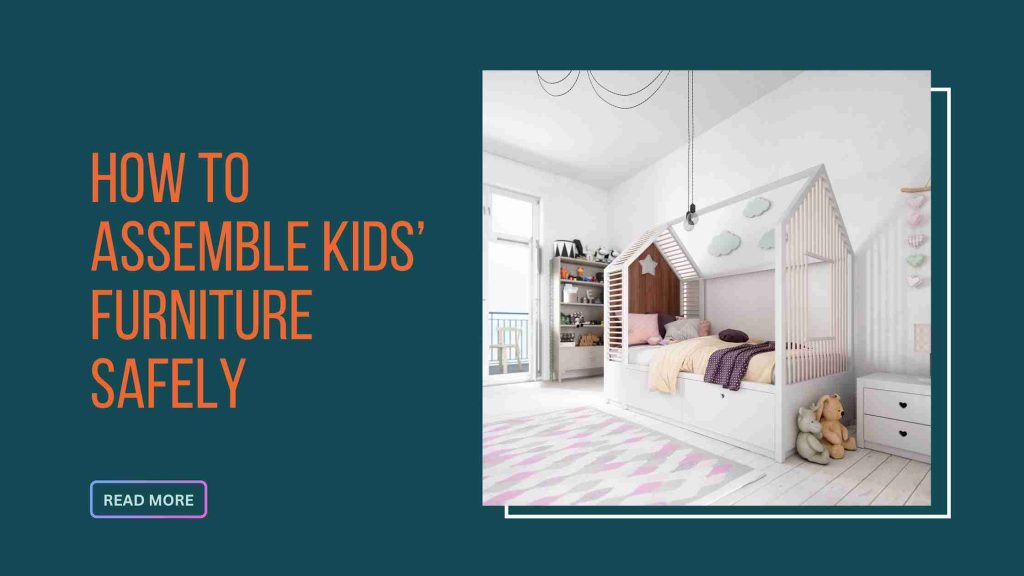When it comes to children, safety is everything. From toys to room décor, every piece of furniture in a child’s environment should meet high safety standards. This becomes especially important during the assembly process. Whether you’re putting together a toddler’s bed, a baby crib, or a play table, one mistake could lead to an accident. Properly assembling furniture for your child isn’t just about following instructions—it’s about ensuring long-term durability, stability, and peace of mind.
Here’s a comprehensive guide for parents and caregivers on how to assemble children’s furniture safely, covering standards, tips, and when to get professional assistance.
Important Safety Standards
Before you even begin the assembly process, make sure the furniture meets all required safety regulations. Not all children’s furniture is created equal, and some may lack the structural integrity needed for safe daily use.
Know the Regulations
Look for items that comply with safety certifications such as:
- ASTM International (American Society for Testing and Materials)
- JPMA (Juvenile Products Manufacturers Association)
- CPSC (Consumer Product Safety Commission) guidelines
For example, baby cribs must meet strict federal safety standards in the U.S., including:
- Slats no more than 2 3/8 inches apart
- No drop-side designs
- Proper labeling and assembly instructions
- Stable, tight-fitting hardware
These requirements are non-negotiable. Buying second-hand furniture may save money, but always double-check that older items meet current safety standards.
Use Child-Safe Materials
Ensure that all components, especially screws and bolts, are made of non-toxic materials. Avoid furniture with sharp edges, peeling paint, or exposed nails or staples.
For kids furniture assembly safety, opt for items labeled as BPA-free, lead-free, and finished with water-based paint. Kids are curious by nature—they may chew, pull, or climb—so even the smallest design choice can become a safety issue.
Assembly Tips for Stability
Whether you’re assembling a bunk bed, a high chair, or a toy chest, stability should be your top priority. Children often play hard, jump on beds, and test furniture in ways adults might not expect.
Read the Manual—Twice
While it may be tempting to start immediately, take time to read through the instructions thoroughly before lifting a tool. Familiarizing yourself with the parts and process helps avoid mistakes and ensures that nothing critical is missed.
It’s common for parents to rush through children’s bed assembly, especially after a long day, but improper construction can result in wobbling, tip-overs, or worse.
Use the Right Tools
Always use the tools specified by the manufacturer. Many kits include a small Allen wrench or screwdriver, but for sturdier results, use your own reliable tools. If screws don’t tighten fully or holes don’t align, don’t force it—this might strip the hardware or damage the frame.
A power drill may speed things up, but over-torquing screws can weaken joints. Tighten just enough to keep joints secure without stressing the wood or metal.
Anchor to the Wall
Furniture that can tip—like dressers, bookshelves, or changing tables—must be anchored. Anti-tip kits are usually included with these items and are easy to install. They keep heavy furniture from falling if a child pulls on drawers or climbs up.
Even lightweight units can cause serious injuries if they fall. This is why kids furniture assembly safety always includes tip-over prevention.
Double-Check Moving Parts
If the furniture has drawers, wheels, or hinges, make sure everything moves smoothly and locks securely. Loose wheels or poorly secured hinges can result in pinched fingers or rolling furniture.
For baby cribs, ensure the mattress support is firmly attached and that the mattress fits snugly within the frame—no more than two fingers should fit between the mattress and the crib walls.
Trusted Help for Parents
Even with clear instructions, furniture assembly can be intimidating, especially when it involves your child’s safety. Some parents opt to bring in professionals to handle complex or critical setups.
When to Call a Pro
If you’re unsure about your abilities or don’t have the right tools, consider hiring a baby crib installer or a professional who specializes in children’s furniture. These pros are familiar with current safety guidelines and can ensure everything is assembled properly.
They can also handle larger or multi-step items like bunk beds or playhouses. For many parents, the peace of mind is worth the cost.
A professional can help you:
- Confirm that pieces meet all safety standards
- Anchor furniture correctly to walls
- Reinforce joints and weight-bearing areas
- Complete the assembly faster and more securely
Finding the Right Help
Search for certified local handymen or companies specializing in family-friendly furniture setups. Look for reviews that mention children’s bed assembly or crib setup to ensure they have relevant experience.
Keywords like baby crib installer or “safe kids furniture assembly near me” will help filter for safety-focused services.
Maintenance Tips After Assembly
Even after assembly, it’s important to periodically check the furniture to ensure it remains safe.
- Tighten screws and bolts every few months
- Look for signs of wear, like wobbly legs or chipped finishes
- Adjust parts like crib mattress levels as your child grows
Proper kids furniture assembly safety isn’t a one-time task—it’s an ongoing commitment to your child’s well-being.
Final Thoughts
Assembling children’s furniture safely requires more than just following a manual. It involves knowing the safety standards, using the right tools, securing every component, and sometimes reaching out to a professional. Whether you’re handling children’s bed assembly yourself or hiring a baby crib installer, your focus should always be on preventing hazards and creating a stable, comfortable space for your child.
Kids grow fast, and their furniture needs change often—but the importance of safety never goes away. By following these steps, you’re investing not just in furniture, but in your child’s safety and peace of mind for years to come.



